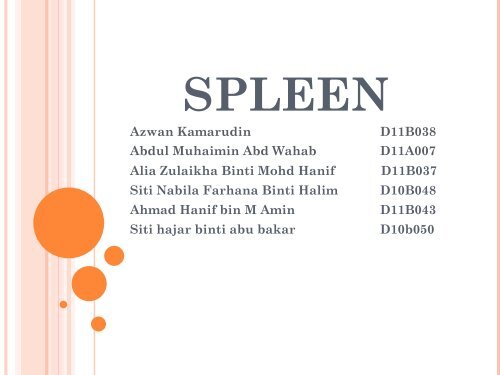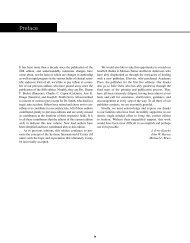group 4 SPLEEN - UMK CARNIVORES 3
group 4 SPLEEN - UMK CARNIVORES 3
group 4 SPLEEN - UMK CARNIVORES 3
You also want an ePaper? Increase the reach of your titles
YUMPU automatically turns print PDFs into web optimized ePapers that Google loves.
SHAPES OF <strong>SPLEEN</strong> Horse Pig Carnivores Small ruminants Ox Avian: Falciform: Tongue-shape: Boot-shape: Leaf-shape: Wide strap: Oval
Falciform
Tongue-shape
LEAF-SHAPE
Wide strap
Spleen
BLOOD SUPPLY AND INNERVATION Blood vessels• Artery• Vein: Splenic artery and celiac artery: Splenic vein (drains into portal vein)• Passed through hilus• Course in trabeculae (repeated branching to smallerdiameter)• Further branching leaves trabeculae and surrounded bylymphoid tissues forming central arteries within whitepulp.• Branch again into about 50 small straight arterioles openinto capillary bed.
BLOOD SUPPLY AND INNERVATION NERVE• Receives parasymphatetic and symphatetic nerve fibersfrom solar plexus LYMPHATIC DRAINAGE• To the splenic lymph nodes (located at the hilus)• Efferent vessel joins the celiac trunk to drain into chylecistern.
HISTOLOGY OF <strong>SPLEEN</strong>
Contains largest collection of reticulo-endothelial cells The spleen is surrounded by a capsule which consists of-smooth muscles-collagen-elastic fibres In horses and cows two or three layers of muscle areoriented perpendicular to each other, while incarnivores, pigs, sheep, and goats the muscle fibers areinterwoven.
The capsule is thickest in the horse and cow, thinnestin carnivores. Trabeculae project into the interior of the spleen fromthe capsule. Large in cows and sheep The spleen of the chicken is covered by a muscularcapsule, but trabeculae are absent.
The parenchyma of the spleen is divisible into thewhite and red pulp Soft, dark red mass is the red pulp. Consists of large, irregular, thin-walled blood vessels,the splenic sinusoids, interposed between sheets andstrands of reticular connective tissue, the splenic cords White pulps contain lymphatic follicles.
The capsule of the spleen of thehorse contains layers of smoothmuscle oriented at right angles toeach other.In this preparation there are threedistinct layers of muscle.Capsule, Spleen, Cow.The capsule contains twothick layers of smooth muscleoriented at right angles to eachother.
Spleen, Chicken. Red pulp (pink)intermingles with white pulp(purple). The white pulp conta insa few lymphatic nodules.Trabeculae of connective tissue areabsent.Capsule, Spleen, Chicken.Layers of smooth muscle make upa substantial part of the capsule
Spleen (horse).(1) Fibromuscular capsule.(2) Fibromuscular trabeculae.(3) Splenic pulp. H & E. ×12.5Spleen (cat).(1) Part of a trabecula.(2) Ellipsoid.(3) Bloodfilled sinusoids of the redpulp.H & E. ×250
<strong>SPLEEN</strong> FOR DOG, PIG ANDSHEEP
<strong>SPLEEN</strong> The largest mass of lymphatic tissue in the body. Found between stomach and diaphragm. Has a hilus (hilium) like the lymph nodes, whichis where the major blood vessels enter and leave. Only has efferent lymph vessels like the thymus,which leave from the hilium, and it does not haveafferent lymph.
TYPE OF TISSUES White pulp• contains lymphoid aggregations, mostly lymphocytes,and macrophages which are arranged around thearteries. The lymphocytes are both T (mainly T-helper) and B-cells. Red pulp• is vascular, and has parencyhma and lots of vascularsinuses. These are sinuosoids - a specialised type ofcapillary, which is very leaky.
Sinusoidal spleen: dogs, rabbits and man• the red pulp contains typical venous (splenic, vascular)sinuses. These are wide channels lined by elongated,longitudinally oriented endothelial cells. Nonsinusoidal spleen: horse, ruminants, cats, pigs• Having poorly developed or no sinuses. Wisps of smoothmuscle in the red pulp are most numerous in pigs andruminants.
DOGA narrow vessel (v) courses through a wide macrophage sheath(e). Pariental lymphatic sheath (P): red pulp (R). Hematoxylinand eosin.
SHEEPAn artery of the wihte pulp(a). is ensheathed with lymphocytes that constitute theperiarteria lymphatic sheath (PALS:P). A nodule (n). is embeddedwithin the PALS. Sheathed capillaries or elipsoids aresurrounded by a wide macrophage sheath. (e). red pulp (R).Hematoxylin and eosin.
ANATOMICAL & HISTOLOGICALCHANGES DUE TODISTURBANCES(HISTOLOGY AND EFFECTS )
Spleen torsionAspleniaTumorSplenomegalyHematoma
ASPLENIA Asplenia refers to the absence of normal spleenfunction and is associated with some serious infectionrisks Hyposplenism is used to describe reduced ('hypo-')splenic functioning, but not as severely affected aswith asplenism.
TUMOR Tumors of the spleen are common in olderdogs. Most enlargement of the spleen is notcancerous and due to blood accumulating asa result of poor circulation, often withbleeding within the spleen (hematomas). Tissue overgrowths (hyperplasias), either oflymphoid cells or macrophages with fibroustissue (fibrohistiocytic nodules) are alsocommon. Less commonly, enlargement is dueto infection or inflammation of the spleen(splenitis).
SPLENOMEGALY
TrabeculaeGerminalcentrecentral arterySimilarly, the fibrous tissue ofsplenic trabeculaeWhite Pulplymphocytessurroundcentral arteriesRed PulpRed bloodcellsSplenicsinusesSplenic cords
HEMATOMA Splenic hematoma is an enlargement of thespleen that is caused by poor circulation throughthe spleen, or bleeding within the spleen due toweak and/or ruptured splenic blood vessels. Splenic hematomas can lead to mild enlargementof the spleen, but many cases present with verylarge, grossly abnormal spleens.
Left, a: Spleen with capsular hematoma(hematoxylin-eosin, original × 2). Right,b: Spleen with parenchymal hematoma(hematoxylin-eosin, original × 10).
Normal spleen white pulp and red pulpH & E 4 X 10
WHAT ARE FOUR OF THEFUNCTION OF THE <strong>SPLEEN</strong>?
The spleen is the largest lymphoid organ of the body.Unlike the lymph nodes in that the circulating fluid isblood instead of lymph. Function of the Spleen :• Filter• Produces lymphocytes• Destruction of erythrocytes• Iron storage
GROSS ANATOMY
Splenic pulp is red because of the blood that is heldwithin the reticular fiber mesh, which represents thepart of the spleen that acts as a filter (mononuclearphagocytic system- MPS) ; it has numerous fixed ofmacrophages. The white pulp is lymphatic tissue distributedthroughout the spleen as lymphatic nodules thatproduces lymphocytes. The blood circulates trough the spleen, and the spleen isactive in the destruction of aged and abnormalerythrocytes by the numerous MPS cells. The spleen also is a storage depot of iron obtained fromthe destruction of erythrocytes.
THE END
The spleen is the largest accumulation of lymphoid tissues in the body. It issurrounded by a capsule of dense connective tissue that sends outtrabeculae, which penetrate and divide the underlying parenchyma, orsplenic pulp. White pulp (stained red) is characterized by the presence oflymph nodules and central arteries (CA), or white pulp arteries. The red pulpis characterized by the presence splenic cords (Billroth's cords), that liebetween sinusoids. The spleen, like other lymphoid organs, has an elaborate,supporting network of reticular fibers.
White Pulplymphocytes surround centralarteriesas periarterial lymphoid sheath(PALS)Red PulpRed blood cellsSplenic sinusesSplenic cords
This slide illustrates the distribution of reticular fibres in the spleen. Theyoften appear coarser in the red pulp, where they have a distinct, strandedorganisation. The reticular fibres of the white pulp appear somewhat finerand, at times, they are arranged as concentric rings. The peripherallocalisation of the central arteries in nodules is quite distinct. Occasionallyyou may see small rings of reticular fibres in (or close to) the periphery ofthe white pulp. These rings are likely to represent the reticular fibressurrounding sheathed arteries.
This is an example of continuous type of Splenic-Gonadal fusionwhere the splenic tissue is intimately connected to the testis by fibroustissue. In discontinuous type, there is no connection between spleenand splenogonad. The splenic tissue is present within tunicaalbuginea, scrotum, or along vascular pedicle. Most cases of splenicgonadalfusion are seen on the left side.
















